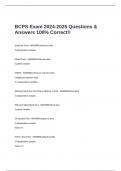Exam (elaborations)
BCPS Exam Questions & Answers 100% Correct!!
- Course
- Institution
Unpaired T-test - ANSWERContinuous data 2 independent samples Paired T-test - ANSWERContinuous data 2 paired samples ANOVA - ANSWERContinuous outcome data Categorical exposure data 3+ independent variables Wilcoxon Rank Sum Test (Mann-Whitney U Test) - ANSWEROrdinal data 2 independent...
[Show more]



